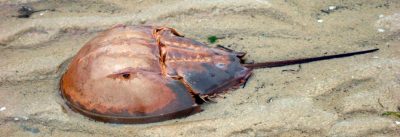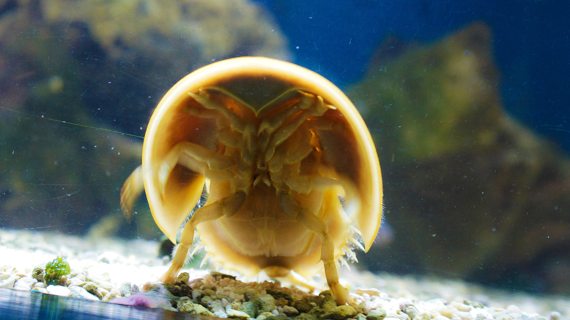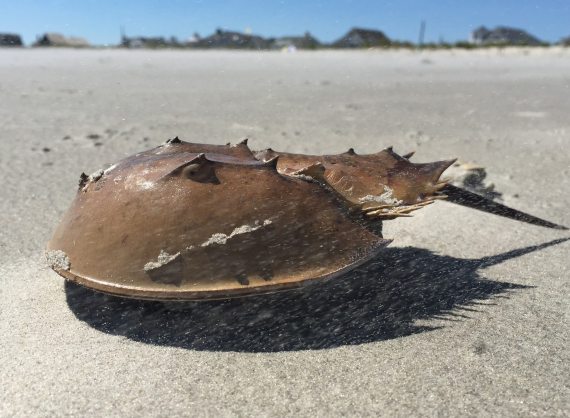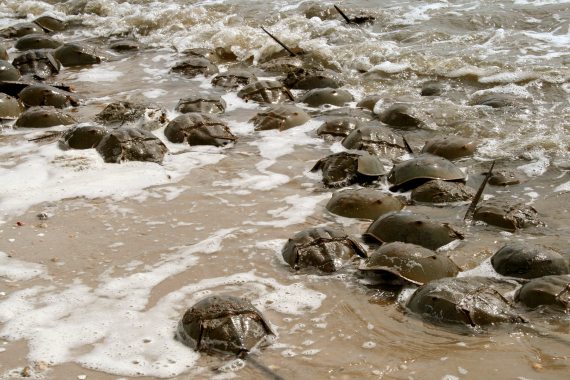Will Coronavirus Vaccine Testing Bleed the Horseshoe Crab Dry?

As the COVID-19 pandemic continues its relentless march across the globe, the unanticipated consequences are reaching every corner of our crowded planet. One such corner is Delaware Bay on the northeast seaboard of the United States, an estuary whose vast expanse of salt marsh wetlands serves as a breeding ground for the Atlantic (or American) horseshoe crab (Limulus polyphemus). With its bizarre helmet-like appearance, which has remained virtually unchanged for many millions of years, this species is what is known as a “living fossil.” Having survived repeated mass extinctions, this amazing blue-blooded animal is under siege from the biomedical industry, and conservationists warn that current efforts to develop and test coronavirus vaccines could accelerate its disappearance from the seas.
Blue Bloodletting
The nexus of the biomedical industry’s interest in the horseshoe crab lies in its blue blood —oxygen is transported by copper, not iron, giving it a blue colour— which contains a protein that is extremely sensitive to bacterial contamination, forming a clot when it encounters a pathogen. The clotting agent, called limulus amebocyte lysate, or LAL, the most sensitive indicator of bacteria ever discovered, is widely used to test implants and injectable medicines, including vaccines, for the presence of bacterial contaminants, called endotoxins, which can lead to aseptic shock and even death.
Image on the right is from Needpix

To obtain the highly coveted LAL —currently valued at around 25,000 euros a litre— an industry has emerged that transports hundreds of thousands of these marine arthropods annually to nearby facilities where laboratory technicians puncture the animal’s shell and drain about 30% of its blood from a vein near the heart. After the bleeding process, the disoriented animals are released back into the wild, although some reports claim that unscrupulous operators have sometimes sold the bled crabs for baitinstead of returning them to the water.
Larry Niles, a wildlife and habitat-restoration biologist associated with the conservation organization Horseshoe Crab Recovery Coalition, explained to OpenMind that “it takes about 300 crabs to make a quart [of LAL] and the international industries bleed about 600,000 crabs a year, mostly coming from Delaware Bay.” While most animals do survive the arduous process, “numerous papers have shown the mortality rate is twice that reported by the industry, not 15% but closer to 30%,” explains Niles, adding that “published studies show that bleeding reduces the potential for breeding.”
Conservationists fear that the billions of doses of coronavirus vaccine coming down the pipe will drastically increase the demand for LAL and “open the door to the massive killing of crabs.”
An Animal-friendly Alternative
A synthetic substitute for LAL known as Recombinant Factor C (rFC) has been available for nearly two decades and has recently been approved for widespread use by the European Pharmacopeia Commission. However, on May 29, 2020, the U.S. Pharmacopeia (USP), the organisation that makes decisions about drug safety in the USA, announced that the rFC test requires two more years of study before it can be approved for use in the USA.
Image below is from domdomegg

USP’s decision means that U.S. drug manufacturers wishing to use the more sustainable synthetic test will need to invest more time and money to demonstrate its equivalency to the LAL test, and companies that want to export medicines to the USA, including potential coronavirus vaccines, will have to continue testing them using LAL from horseshoe crab blood. Industry observers such as Niles are suspicious: “The USP was ready to adopt rFC, then abruptly changed course, saying that one stakeholder requested it. We think the bleeding companies intervened, but the process is secretive.”
Niles would like biomedical laboratories to “adopt a no mortality goal and conduct an open adaptive management process to reduce kills that can be verified independently,” and that the USP approve the use of rFC as a replacement for LAL. He also calls for the end of the practice of using horseshoe crabs as bait.
Scary-looking but Harmless
Although referred to as crabs, Limulus polyphemus are actually marine arthropods, more closely related to spiders, and especially scorpions, but unlike their venomous cousins, these armoured creatures are completely harmless. While their long, pointed tail (called a telson) may look menacing, it contains no venom and is used to help them if they get flipped over by a wave. Their set of ten spindly legs and pinchers may inspire nightmares, but they are only used to mash food (primarily clams and mussels) before pushing it into their toothless mouth situated between the legs.
Image on the right is from Pxhere

The horseshoe crab gets its name from the horseshoe shaped exoskeleton that protects its interior. Ten different eyes (or light sensing organs) are distributed around the body, the study of which led in part to the awarding of the 1967 Nobel Prize in Physiology or Medicine to Ragnar Granit, Haldan Keffer Hartline and George Wald for discoveries concerning the visual processes of the eye.
Millions of Eggs Support an Ecosystem
As a keystone species, the horseshoe crab “is a vital source of almost unimaginable natural wealth,” says Niles. During the spawning season, which normally occurs in May and June, females lay two clusters totalling about 80,000 eggs, about 15 centimetres into the sand. “Six of the most threatened Arctic nesting shorebirds rely on horseshoe crab eggs to build fat reserves to fuel the flight to the Canadian Arctic and the start of incubation,” he tells OpenMind. The eggs and larvae also feed a variety of young fish and “the dead crabs help to provide nutrients for buried developing eggs,” he adds.
Image below: Asturnut

While the Atlantic horseshoe crab population seems to have stabilised somewhat after crashing during the 1990s due to overharvesting for bait for commercial fisheries, the other three horseshoe crab species, all located in Asia, are all trending downward under intense pressure from human consumption, the production of TAL (the Asian equivalent to LAL), rapid habitat loss and global warming.
However, one should think twice before betting against the horseshoe crab’s continued long-term survival, given that the species has been inhabiting the oceans for at least 450 million years (predating flying insects and flowering plants), while successfully navigating inconceivable climate change and surviving several previous extinction events, including the meteor impact that wiped out the dinosaurs. This is clearly a species with an impressive track record for survival, something that cannot yet be said of the humans drawn to its remarkable blue blood and the riches it contains.
*
Note to readers: please click the share buttons above or below. Forward this article to your email lists. Crosspost on your blog site, internet forums. etc.

